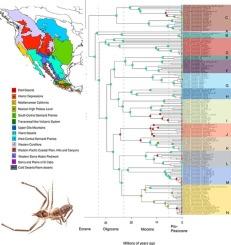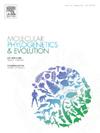Historical biogeography and the evolution of habitat preference in the North American camel spider family, Eremobatidae (Arachnida:Solifugae)
IF 3.6
1区 生物学
Q2 BIOCHEMISTRY & MOLECULAR BIOLOGY
引用次数: 0
Abstract
Abiotic variables can influence species distributions, often restricting taxa to an acquired climatic signature or conversely, related species are conserved in the same ecological space over millions of years. An investigation into how abiotic change has shaped geographic distributions of taxa may be key to understanding diversification of lineages, and in the absence of reliable morphological characteristics, such information may support taxonomic units at multiple scales.
Here, we examine the historical biogeography and patterns of habitat preference within the North American solifuge family, Eremobatidae. A previous study demonstrated that a major taxonomic revision of Eremobatidae is warranted, however recent studies demonstrate high levels of morphological convergence within the group, thus a re-classification of generic boundaries using additional information must be prioritized before we can formally begin solid revisionary efforts. In this study, we aimed to reconstruct a well-resolved phylogenetic hypothesis of Eremobatidae by filtering UCE loci based on informativeness, by mitigating the effect of cogenic UCE on phylogenetic estimation, and by supplementing our curated UCE loci with mitochondrial information. Using our preferred topology, in conjunction with published estimated divergence dates for Eremobatidae, we inferred a time-calibrated phylogenetic hypothesis to inform the historical biogeography and patterns of habitat preference. The two major habitat types that were observed for Eremobatidae were warm deserts for early diverging taxa and a subsequent evolution to cold deserts and Mediterranean California ecoregions for later diverging taxa. Eremobatid niche space, determined by temperature and precipitation, has been conserved for at least 25 million years in North America, supporting a warm desert origin, and thus supporting high species richness in the Sonoran and Mexican Plateau. Overall, our study provides support for new generic level designations within Eremobatidae.

北美骆驼蜘蛛科 Eremobatidae(蛛形纲: Solifugae)的历史生物地理学和栖息地偏好进化。
非生物变量会影响物种的分布,通常会将类群限制在后天的气候特征中,或者相反,相关物种在数百万年中保存在同一生态空间中。研究非生物变化如何影响类群的地理分布可能是了解类群多样化的关键,在缺乏可靠的形态特征的情况下,此类信息可能支持多种尺度的分类单元。在此,我们研究了北美溶岩科(Eremobatidae)的历史生物地理学和栖息地偏好模式。之前的一项研究表明,有必要对Eremobatidae进行一次重大的分类学修订,但最近的研究表明,该类群内部存在高度的形态学趋同,因此在正式开始扎实的修订工作之前,必须优先利用更多的信息对属界进行重新分类。在本研究中,我们根据信息量筛选 UCE 位点,减轻同源 UCE 对系统发育估计的影响,并利用线粒体信息补充我们策划的 UCE 位点,从而重建了 Eremobatidae 的系统发育假说。利用我们首选的拓扑结构,并结合已发表的 Eremobatidae 的估计分化日期,我们推断出了一个经过时间校准的系统发育假说,为历史生物地理学和栖息地偏好模式提供了信息。我们观察到 Eremobatidae 的两种主要栖息地类型:早期分化类群的栖息地是温暖的沙漠,而后期分化类群的栖息地则演变为寒冷的沙漠和地中海加利福尼亚生态区。由温度和降水决定的Eremobatid生态位空间在北美洲至少保存了2500万年,支持了温暖沙漠的起源,从而支持了索诺拉和墨西哥高原的高物种丰富性。总之,我们的研究为 Eremobatidae 新的属级命名提供了支持。
本文章由计算机程序翻译,如有差异,请以英文原文为准。
求助全文
约1分钟内获得全文
求助全文
来源期刊
CiteScore
7.50
自引率
7.30%
发文量
249
审稿时长
7.5 months
期刊介绍:
Molecular Phylogenetics and Evolution is dedicated to bringing Darwin''s dream within grasp - to "have fairly true genealogical trees of each great kingdom of Nature." The journal provides a forum for molecular studies that advance our understanding of phylogeny and evolution, further the development of phylogenetically more accurate taxonomic classifications, and ultimately bring a unified classification for all the ramifying lines of life. Phylogeographic studies will be considered for publication if they offer EXCEPTIONAL theoretical or empirical advances.

 求助内容:
求助内容: 应助结果提醒方式:
应助结果提醒方式:


